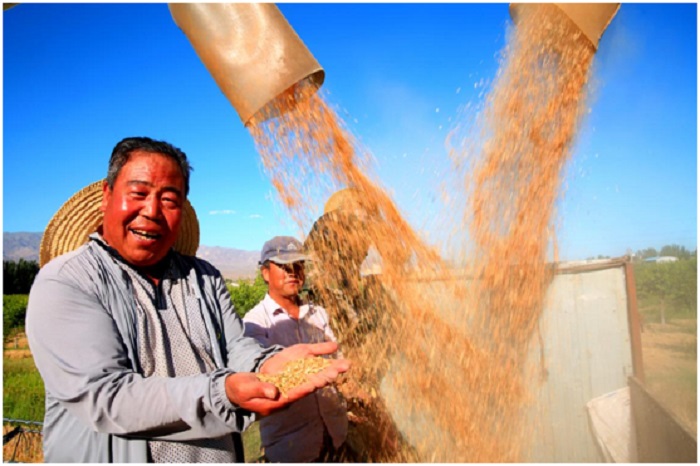



China’s annual water consumption in the agricultural irrigation sector has been maintained at around 340 billion cubic meters over the past 30 years, accounting for 56 percent of the country’s total water use, according to a water-saving forum recently held in Jiuquan, northwest China’s Gansu province.
With 6 percent of the world’s freshwater and 9 percent of the world’s arable land, China is providing food for around 20 percent of the population on the planet. That’s not easy for a populous country with an extremely uneven distribution of water resources.
Water-saving irrigation has made vital contributions to China’s stable agricultural water consumption. As of 2020, water-conserving irrigation had been applied on 567 million mu, or 37.8 million hectares of farmland across China, and 350 million mu of land was irrigated with high-efficient water-conserving techniques, such as sprinkler, mini sprinkler and pipeline irrigation. The coefficient of effective use of water in farmland irrigation was 0.565.
China has constantly upgraded the supporting and water-conserving systems for its medium- and large-size irrigation areas. Thanks to the efforts, a series of ancient irrigation systems are still vigorous today, including the Dujiangyan in southwest China’s Sichuan province, the Jinghui canal in northwest China’s Shaanxi province, the Hetao irrigation area in north China’s Inner Mongolia autonomous region, and the Qingtongxia irrigation area in northwest China’s Ningxia Hui autonomous region. Besides, the country is also building new irrigation areas. As a result, China’s effective irrigation area has grown from 240 million mu in 1949 to 1.04 billion mu at present, making it the country with the largest irrigation area in the world.
Through a reform in the water price, a water conservation campaign was kicked off across China. From 2018 to 2020, China allocated 4.5 billion yuan ($695 million) to advance a mechanism for the pricing of agricultural water consumption, a mechanism subsidizing and incentivizing those who conserve water, a mechanism for water engineering construction and maintenance, and a mechanism for water use management. By the end of the last year, comprehensive agricultural water pricing reform had been implemented on around 400 million mu of farmland, with Beijing, Shanghai, Jiangsu and Zhejiang taking the lead to complete reform missions. In addition, the reform has taken effect on almost all the farmland irrigation areas in Tianjin and Shaanxi.
Chen Mingzhong, director of the Rural Water Resources and Hydropower Department under China’s Ministry of Water Resources, introduced that China has invested huge amounts of central government subsidies on constructing supporting systems and upgrading water conservation systems in medium- and large-size irrigation areas. Water resource departments will keep expanding the investment, make further innovations in financing and investment mechanisms, make good use of local government bonds, and encourage and attract social capital, he added


The Humanitarian Service Diamond Awards has.
A Chinese Company, Inner Galaxy Steel.


The Programme Coordinator, Regulatory, Compliance and.


A Non-Governmental Organization (NGO), Committee for.
The Trustfund Pensions Limited has chided.


The House of Representatives Committee on.
The China General Chamber of Commerce.


Senator Chuka Utazi who represented Enugu.


An Abuja based Legal Practitioner, Ugochukwu.


The African business community in Yiwu,.
Leave a Comment